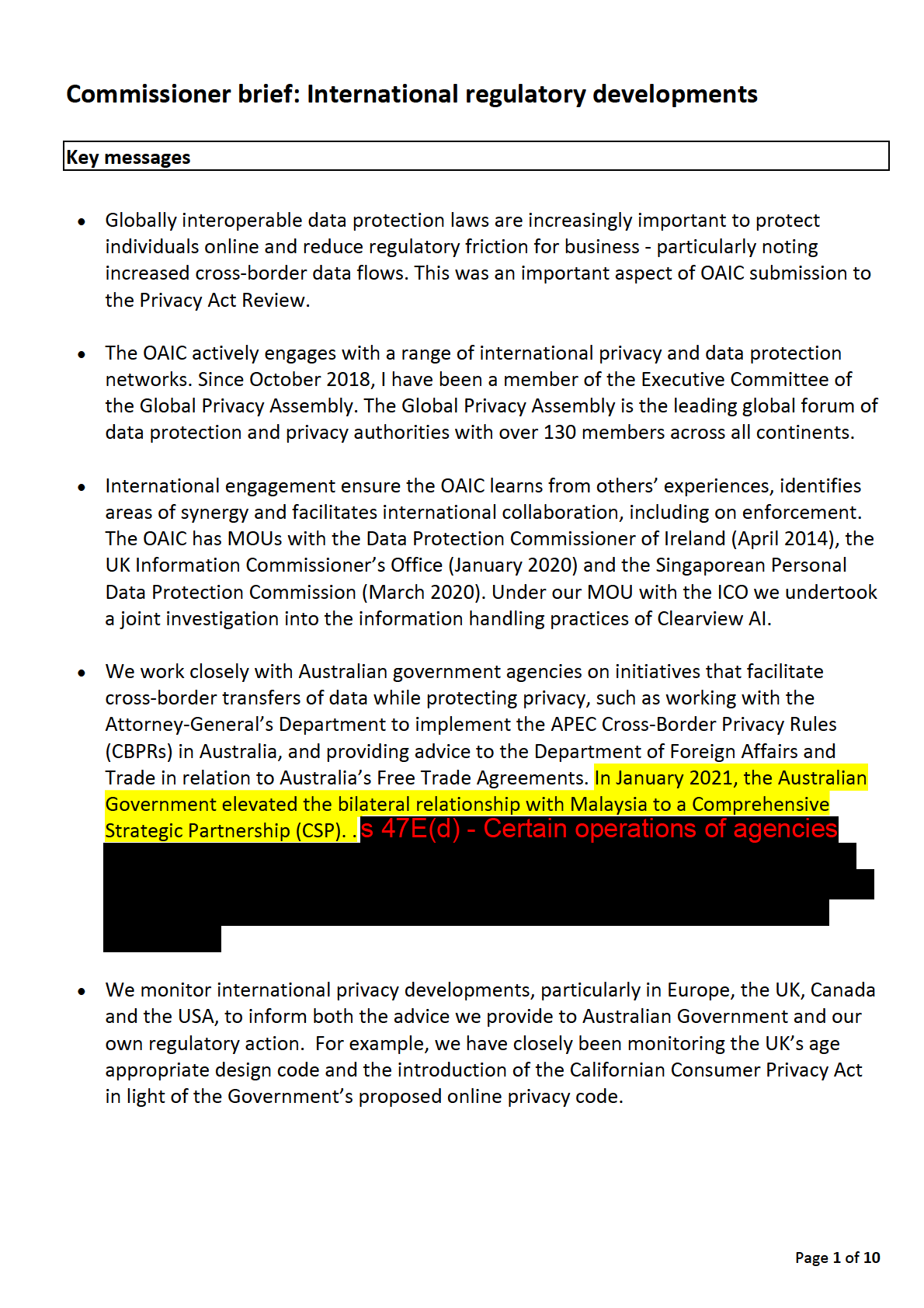

Commissioner brief: Biometrics
Key messages
• The OAIC has privacy oversight of Identity-Matching Services such as the National Facial
Biometric Matching Capability (NFBMC) and the National Drivers Licence Facial
Recognition Solution (NDLFRS), which involve the col ection and handling of large
volumes of sensitive information.
o We are engaging with the Department of Home Affairs (Home Affairs) on an MoU
to conduct 2 privacy assessments, one each for the NFBMC and NDLFRS.
• We continue to engage with Home Affairs to incorporate additional safeguards into the
draft legislation and the NFBMC’s associated governance framework. s 47E(d) - Certain operations of agencies
o The Parliamentary Joint Committee on Security and Intel igence’s (PJCIS’s)
advisory report on
the Identity-Matching Services Bil 2019 (the IMS Bil )
recommended redrafting to include amongst other things more robust privacy
safeguards (Rec 1).
Critical facts
• Home Affairs operates the NFBMC to prevent identity crime, and for general law
enforcement, national and protective security, and identity verification purposes. The
NFBMC facilitates the sharing of facial images between the Commonwealth and states
and territories, through its identity-matching services.1
• The IMS Bil and the Australian Passports Amendment (Identity-Matching Services) Bil
2019 provide the legal framework for Home Affairs to operate identity-matching
services. The OAIC made a submission to the PJCIS in 2018,2 recommending that Home
Affairs specified privacy protections applicable to the NFBMC within its overarching
legislation. The OAIC has also provided Home Affairs with a range of policy advice in
relation to the NFBMC’s governance documents. s 47E(d) - Certain operations of agencies
• In December 2019, the Australian Human Rights Commission’s (AHRC) released its
Discussion Paper on Human rights and Technology recommending that the Australian
Government implement a legal moratorium on facial recognition technology (FRT) until
it introduces a suitable legal framework.3
1 Services include the Face Verification Service (‘one to one’ matching) and Face Identification Service (‘one to many’ matching). The NDLFRS
(as part of the NFBMC) wil be a centralised database of driver licence holdings from every state and territory
2 OAIC,
Review of the Identity-matching Services Bil 2018 and the Australian Passports Amendment (Identity-matching Services) Bil 2018 —
submission to Parliamentary Joint Committee on Intel igence and Security, 2018 < https://www.oaic.gov.au/engage-with-
us/submissions/review-of-the-identity-matching-services-bil -2018-and-the-australian-passports-amendment-identity-matching-services-bil -
2018-submission-to-parliamentary-joint-committee-on-intel igence-and-security/>.
3 See the Australian Human Rights Commission’s Discussion Paper on Human rights and technology (2019),
https://www.humanrights.gov.au/our-work/rights-and-freedoms/publications/human-rights-and-technology-discussion-paper-2019.See
proposal 11 at p.10.
Page
1 of
4

Commissioner brief: Senator Patrick Federal Court
Key messages
s 47E(d) - Certain operations of agencies
Senator Patrick lodged Federal Court proceedings on 9 September 2021 al eging
unreasonable delays in conducting reviews of his IC review applications. The Federal
Court has set a case management and interlocutory hearing for 29 October 2021.
Critical facts
• The
Freedom of Information Act 1982 does not set a timeframe for IC review decisions.
The relevant PBS measure is 80% of IC reviews are finalised within 12 months. In 2019-
2020 the number of IC reviews finalised within 12 months was 72%, in 2020-2021 was
73% and up to 30 September 2021 was 82%.
• The proceedings relate to 23 applications for Information Commissioner review, of
refusals or partial access decisions by government departments on FOI applications
made by Senator Patrick. s 47E(d) - Certain operations of agencies
• Senator Patrick issued a media release about the Federal Court proceedings on 10
September 2021 (Federal court action commenced to tackle PMs transparency allergy).
Senator Patrick also posted news on his Twitter account on 10 September 2021 and his

Commissioner brief: Budget and resourcing February 2022
KEY MESSAGES
•
Total appropriation for 2021-22 is $26.730mil ion
•
2021-22 ASL – cap 147; the internal budgeted cap 127; Actual FTE at 31 December
2021 is 111.
•
The 2021-22 Budget provided ongoing funding for FOI Commissioner appointment.
•
2021-22 MYEFO provides additional $1.997mil ion for transition of ICT services and
Federal Court proceedings. It also provides $0.912 for the expansion of Digital Identity
in 2022-23.
•
Funding reduces from 1 July 2022 due to terminating measures.
KEY BUDGET NOTES
1 July 2021
•
MYEFO 2021-22 increased revenue by $1.447 mil ion from $25.283mil ion to
$26.730mil ion. Total capital revenue increased from nil to $0.550mil ion.
Funding is for:
o Transition of ICT shared services $1.098mil ion plus $0.550milion capital.
o Federal Court proceedings: $0.349mil ion
•
The published PBS includes $150,000 in MOU funding. Actual MOU is $252,500. (Actual
figures will be updated in 2022-23 PBS.)
•
Total MYEFO published funding is $26.880mil ion including MOU and 147 ASL
•
OAIC wil seek permission to operate at loss of $1.630mil ion for transition of payrol
and finance services to Service Delivery Office. The transition is self-funded.
•
The 2021-22 Budget provides $5.951mil ion across five key areas:
o Transition of ICT shared services $1.098mil ion
o Federal Court proceedings: $0.349mil ion
o Freedom of Information: $980,000
o Expansion of Consumer Data Right: $1.454mil ion
o Digital Health: $2.070mil ion.
Page 1 of 19











